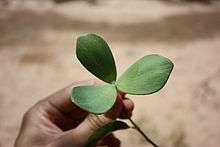Celastraceae
The Celastraceae (syn. Brexiaceae, Canotiaceae, Chingithamnaceae, Euonymaceae, Parnassiaceae, Siphonodontaceae, and Stackhousiaceae), are a family (the staff vine or bittersweet family) of 96 genera and 1,350 species[3] of herbs, vines, shrubs and small trees, belonging to the order Celastrales. The great majority of the genera are tropical, with only Celastrus (the staff vines), Euonymus (the spindles) and Maytenus widespread in temperate climates, and Parnassia (bog-stars) found in alpine and arctic climates.
| Celastraceae | |
|---|---|
 | |
| Oriental staff vine (Celastrus orbiculatus) | |
| Scientific classification | |
| Kingdom: | Plantae |
| Clade: | Tracheophytes |
| Clade: | Angiosperms |
| Clade: | Eudicots |
| Clade: | Rosids |
| Order: | Celastrales |
| Family: | Celastraceae R.Br.[1] |
| Subfamilies[2] | |
| |
The roughly 100 genera include (with common names of some members):
Genera
A complete list of the genera is:
- Acanthothamnus
- Allocassine
- Anthodon
- Apatophyllum
- Apodostigma
- Arnicratea
- Bequaertia
- Brassiantha
- Brexia
- Brexiella
- Campylostemon
- Canotia
- Cassine
- Catha
- Celastrus
- Cheiloclinium
- Crocoxylon
- Crossopetalum
- Cuervea
- Denhamia
- Dicarpellum
- Dinghoua
- Elachyptera
- Elaeodendron
- Empleuridium
- Euonymus
- Euonymopsis
- Fraunhofera
- Gloveria
- Glyptopetalum
- Goniodiscus
- Gyminda
- Gymnosporia
- Hartogiella
- Hartogiopsis
- Hedraianthera
- Helictonema
- Hexaspora
- Hippocratea
- Hylenaea
- Hypsophila
- Kokoona
- Lauridia
- Lepuropetalon
- Loeseneriella
- Lophopetalum
- Lydenburgia
- Macgregoria
- Maurocenia
- Maytenus
- Menepetalum
- Microtropis
- Monimopetalum
- Mortonia
- Moya
- Mystroxylon
- Nicobariodendron
- Orthosphenia
- Parnassia
- Paxistima
- Peripterygia
- Peritassa
- Plagiopteron
- Platypterocarpus
- Plenckia
- Pleurostylia
- Polycardia
- Prionostemma
- Pristimera
- Psammomoya
- Pseudocatha
- Pseudosalacia
- Ptelidium
- Pterocelastrus
- Putterlickia
- Quetzalia
- Reissantia
- Robsonodendron
- Rzedowskia
- Salacia
- Salacighia
- Salaciopsis
- Salvadoropsis
- Sarawakodendron
- Scandivepres
- Schaefferia
- Semialarium
- Simicratea
- Simirestis
- Siphonodon
- Stackhousia
- Tetrasiphon
- Thyrosalacia
- Tontelea
- Torralbasia
- Tricerma
- Tripterococcus
- Tripterygium
- Tristemonanthus
- Wimmeria
- Xylonymus
- Zinowiewia
- Fossil genera

Leaves of Loeseneriella africana

Inflorescence of Gymnosporia senegalensis
gollark: Which have battery lives of years, which is obviously quite useful.
gollark: As you're in a sensible country unlike Solar, you could just get a cheap nonsmartwatch.
gollark: Their nests violate planning permission and they don't pay the fines.
gollark: In my country, yes.
gollark: Although to be honest a Pi0 may be underpowered for general use... so maybe a compute module or SOPine?
References
- Angiosperm Phylogeny Group (2009). "An update of the Angiosperm Phylogeny Group classification for the orders and families of flowering plants: APG III". Botanical Journal of the Linnean Society. 161 (2): 105–121. doi:10.1111/j.1095-8339.2009.00996.x.
- "Celastraceae R. Br., nom. cons". Germplasm Resources Information Network. United States Department of Agriculture. 2003-01-17. Archived from the original on 2009-05-06. Retrieved 2009-04-16.
- Christenhusz, M. J. M. & Byng, J. W. (2016). "The number of known plants species in the world and its annual increase". Phytotaxa. 261 (3): 201–217. doi:10.11646/phytotaxa.261.3.1.
| Wikimedia Commons has media related to Celastraceae. |
This article is issued from Wikipedia. The text is licensed under Creative Commons - Attribution - Sharealike. Additional terms may apply for the media files.